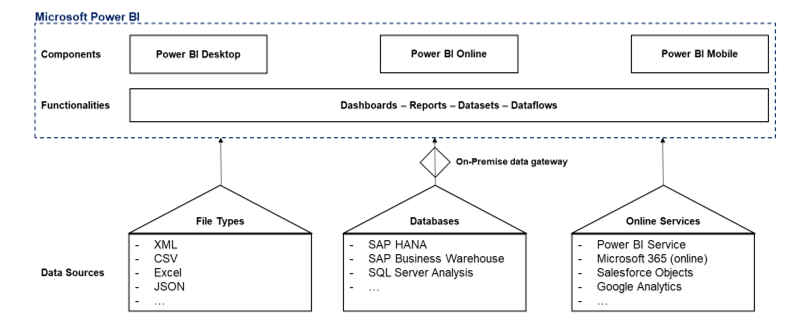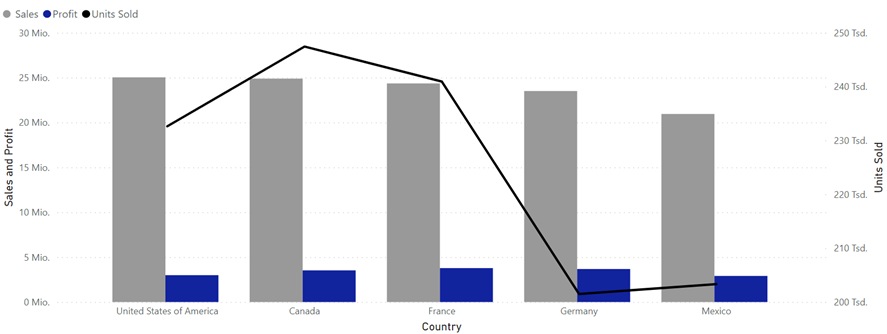Power BI
Power BI and its integration with the SAP world: Alternative to the SAC?
Even though SAP offers sophisticated and comprehensive Business Intelligence (BI) solutions (e.g., SAP Analytics Cloud), many organisations still heavily rely on Microsoft Excel in their day-to-day business. On top of this, Microsoft offers an additional tool within its Office 365 package that goes beyond the capabilities of Excel: Power BI.
Power BI is one of the fastest-growing BI platforms and offers possibilities in analysing data that go beyond those of Microsoft Excel.
Components and integrated architecture of Microsoft Power BI
Power BI is available as a software as a service (SaaS) model via Microsoft Cloud Services (e.g., Office 365 or Azure) or as an on-premise model in the Power BI Report Server. For the connection of on-premise data sources such as SAP BW, the installation of Power BI Desktop and an on-premise data gateway is necessary.

Figure 1: Architecture of Microsoft Power BI
Datasets
Every report is based on a dataset that inhibits the data model. The data model decides how the data from different queries are combined.
Reports
Reports are the key component of Power BI created by users. Visualisations are created based on the underlying dataset and the data model which is saved in the dataset. Reports can be published in the Power BI Service and then accessed by other users.
Dashboards
Dashboards can be prepared based on Power BI reports. The main goal of this functionality is the possibility to compromise and visualize information and insights from several Power BI reports. This is especially useful for decision-makers to get fast insights into different reports.
Dataflows
Power BI dataflows enable the data loading of different data sources in one data model. This data model can then be the basis for Power BI reports.
Power BI: The leading self-service BI tool?
In general, BI tools are characterized by easy-to-use self-service functionalities that support a full analytic workflow: From data preparation to data visualization and insight generation.
One key benefit of Microsoft Power BI is its alignment and integration with Office 365 and Microsoft teams. As these platforms are used by millions of users every day, Power BI has gained and will further gain tremendous reach in the business world. Due to its Microsoft Office Integration, publishing and sharing reports is easier in Power BI compared to other BI tools. Besides, Power BI offers the full range of BI-functionalities, while remaining at a relatively low price (Power BI Desktop is even available for free). It also incorporates the use of augmented analytics or Machine Learning capabilities (Power BI Premium). Further, it is relatively easy to connect Excel queries, data models, and reports to Power BI dashboards. This supports departments in their daily business by quickly gathering, analysing, publishing, and sharing Excel business data in a more sophisticated manner.
Some more benefits are:
- Interactive data analysis
- Creation of own visualisations
- Possible to analyse reports with your Smartphone
- No programming language required
- Fast report creation

Figure 2: Exemplary Power BI chart
How to integrate Power BI with SAP S/4HANA
Power BI can be integrated with SAP HANA database via “ODBC” driver and with SAP BW database via “.NET driver.” In both ways, either a direct query[1] connection or import mode connection is possible. The former is faster in terms of data loading and data access but lacks in terms of fast usability. Contrary, import connections require more time for data loading but have better performance in-memory in the semantic layer and thus, better usability. Therefore, companies need to decide which connection best fits their specific requirements and business needs. A direct query is the best way to connect your SAP data with Power BI if the data to be loaded frequently changes over time and the reports are supposed to always contain the newest data. However, features in a direct query connection are limited compared to an import connection, e.g., data volume limited to one million rows. Thus, companies need to evaluate if they require those additional features inherent in the import connection and decide based on this evaluation. In general, both connection types have several pros and cons. Also, companies that run their SAP system in a cloud can still use Power BI as their analytics tool independent from the cloud provider. All they need is an Office 365 license to connect to Power BI and to the Microsoft Cloud.
This blog article illustrates that Power BI is a powerful BI tool that is particularly attractive because of its connection with Microsoft Excel and its relatively low operating costs. Moreover, the article shows how an integration with an SAP landscape is possible and therefore, Power BI should also be considered as a business intelligence tool for companies with an SAP landscape.
_______________________________
[1] A direct query is equivalent to the live connection used in SAP Analytics Cloud
If you want to get more information on Power BI and its integration with an SAP Landscape, feel free to contact Gerhard Lentz (gerhard.lentz@www.draxingerlentz.de).
